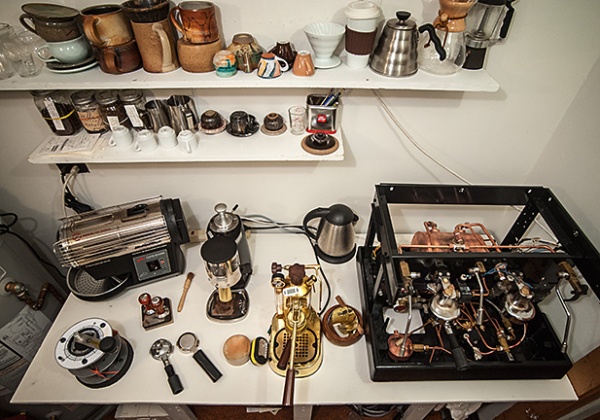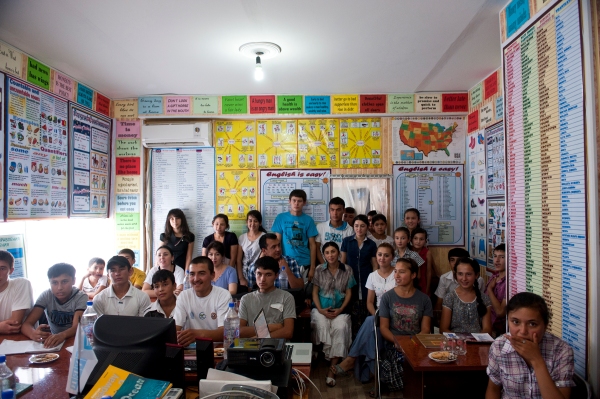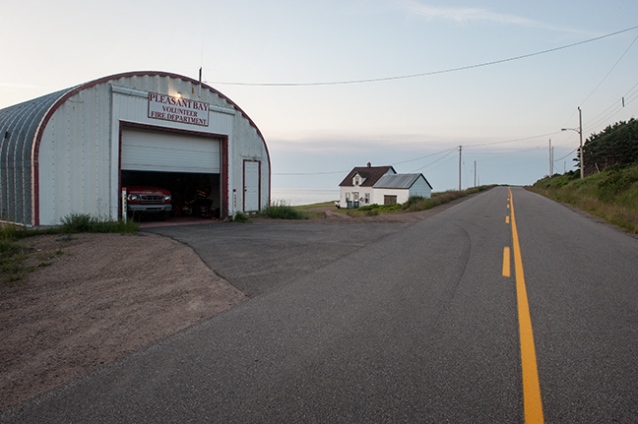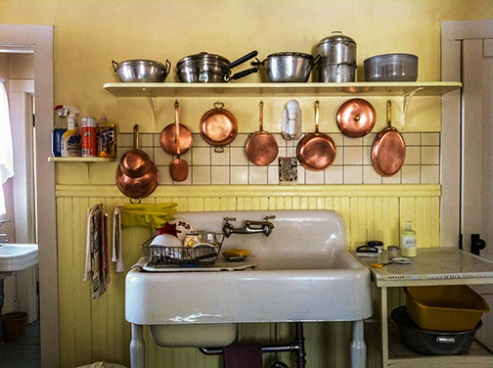Cultural Visions Part Two: Portraits from Tibet

In the 1990s, I took three trips to Tibet. Above- Man in a Basket, 1994.

Chinese military at the Lhasa Airport, 1992.

Man at the Latrine in the Lhasa Ghetto, 1992

Girl with His Holiness the Dalai Lama Photo, 1992
I gave the picture to her in exchange for her portrait. This photo and most of the following pictures were made with my 8X10 inch view camera (70 pounds of equipment). Below, Tibetans taking a look through my dark cloth, 1992.


West Gate, Lhasa, 1994.
This was the celebrated entry point leading into the heart of Lhasa. When the Chinese invaded in the 1950s, they blew up the ancient gate allowing their tanks into Tibet’s largest city . In the 90s, the former gate was still a flashpoint. Tibetans would string prayer flags across the road almost every night. The Chinese soldiers would tear them down during the day.

Rambo guards the door to a Lhasa tea house, 1994

Pool Players with the Potala in the Background, 1994.

Monks in the Gyantse Kumbum, 1992

Lama Gyurme at Dreprung Monastery outside of Lhasa. 1992.

Girl from Amdo near the Lukhang Temple behind the Potala, 1992.

Mother and Child on the Ferry to Samye Monastery, 1994.
More of my pictures from Tibet:
www.socialdocumentary.net/photographer/frankward
It is time for Social Documentary Network’s Call for Entries. This is an opportunity to have your photo work reviewed by some of the world’s top practitioners, photo editors and all around humanitarians. Show us pictures that matter.

Nuns in their temple in Lhasa, 1998.
Cultural Visions Part One: Himalaya

Monk, Ladakh, India, 1974
Back in the ’70s, Thomas Laird, Bill Hamilton and I formed Research Group Triangle. We were supported in part by an Italian philanthropist in Geneva, Switzerland. Our mandate was to document Buddhist culture in India and Nepal. Over a period of several months, we photographed, filmed and recorded audio in Buddhist temples, hermitages and monasteries.

Listening to the ting-shah, Bodhanath, Nepal, 1979
Five years later, in 1978, I returned to Asia with my wife, Vivian Leskes and spent several more months with the Sherpas and Tibetans.

Group Portrait, Junbesi Temple, Solu, Nepal, 1974
I’m the guy with the beard and Tom is standing behind me.

Funeral, Junbesi, 1979
A sick woman arrived in Junbesi one evening trying to get to her Buddhist teacher, Tulshig Rimpoche, before dying. She didn’t make it. She is on the right tied to heavy stones for a river burial. She did not have the money for a traditional sky burial. The ritual was performed by a village lama, with chendar drum in the foreground, and Nyingma Dzogchenpa Lhakpa Drolma, the funeral shaman, reciting prayers to the left. Vivian is sitting on a rock in the background.

Nyingma Dzogchenpa Lhakpa Drolma at the Dumji Festival, Junbesi, Nepal, 1979

Takshindu Lama Leshe in his Monastery apartment, Solu Region, Nepal, 1974

A puja in a village home, Solu Region, Nepal, 1974
The monks and lamas often supported themselves by performing ceremonies for villagers.

Annual Dumji Festival, Junbesi, Nepal, 1979

Monk and Chung-Chung at the Kalachakra Empowerment, Bodhgaya, India, 1974
My first meeting with His Holiness the Dalai Lama and my first experience with Tibetan Buddhism happened at this Kalachakra Tantra ceremony soon after I first arrived in India.
 This initiation took place in a field beside the Bodhi Tree. The original place of the Buddha’s enlightenment 2500 years ago.
This initiation took place in a field beside the Bodhi Tree. The original place of the Buddha’s enlightenment 2500 years ago.

I will continue this series of my early photography of Tibetan culture with a posting about three trips I made to Tibet in the 1990s. Thanks for looking.
HOLYOKE>ZEKE>CUBA
THE MAGAZINE OF GLOBAL DOCUMENTARY
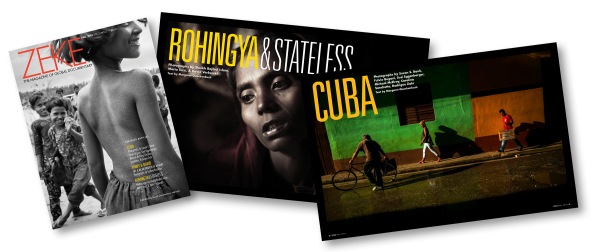
My HeyLook HoLyoke show is now off of the gallery walls. If you want to see an article about it, and me, look here.
ZEKE has just released their fall issue in digital and print. I am on the ZEKE Advisory Board and I say, we need more subscribers to help keep documentary growing. Check it out here. In the most recent issue, I review two books about two cultures. Here is the first review.

 Once in awhile a book comes along that is so beautiful to look at and so painful to contemplate that the mind gets entangled somewhere between the art of seeing and the subject matter being seen. In Paula Bronstein’s devastating Afghanistan Between Hope and Fear, what is seen is not all about beauty. It is often shameful, criminal, repellent, and it is mesmerizing.
Once in awhile a book comes along that is so beautiful to look at and so painful to contemplate that the mind gets entangled somewhere between the art of seeing and the subject matter being seen. In Paula Bronstein’s devastating Afghanistan Between Hope and Fear, what is seen is not all about beauty. It is often shameful, criminal, repellent, and it is mesmerizing.
Afghanistan, with its open deserts and looming mountains, is stunning. The population, comprising about 14 ethnic groups, would offer a dream casting call for any Hollywood movie. Afghanistan’s recent history, beginning with the Russian invasion of 1978 and continuing through the regime of the Taliban and into an unclear future, presents an endless unraveling of despicable events. Both Kim Barker’s Foreword and the Introduction, “Afghan Women,” by Christina Lamb provide some much needed comprehension of Bronstein’s heart piercing photographs.
Kim Barker describes the pictures as “arresting,” “inspiring,” “contradictory,” “compelling,” and “complicated.” Barker also says of Afghanistan that, “Photographs are almost the only way to prove the reality of life there.” Rather than “reality,” Bronstein’s pictures seem more like a fine art re-enactment of an Old Testament fable during the aftermath of World War III. That is not a criticism. Bronstein’s visual effort is the most successful illumination of Afghanistan’s ongoing circumstances yet published. To quote Bronstein’s question from her Afterword, “If conflict is all you ever experience, can happiness ever be defined without it?” Under such circumstances, one could also ask, can beauty ever be defined without it?

Waiting in line, Coppelia, Havana, 2002. Possibly the largest ice cream parlor in the world.
All Cuba photos by Frank Ward
There is a great portfolio about Cuba by several artists in the new ZEKE. The above picture is not included, but there are wonderful, more recent pictures that you should check out. I have not shown my Cuba panoramas in decades. Now’s the time.

Spandex, Havana, 2002

Vegetable Market, Havana, 2002

Pio Lindo, Havana, 2002

Cafe, Havana, 2002

Cigar Factory, Cuba, 2002. Cuban cigar factories are places of higher learning. During work someone is assigned to read one of the great books of literature. Anna Karenina anyone?

Trinidad de Cuba, 2002

Visiting the Pinar Family, Cuba, 2002

Playing Ball, Trinidad de Cuba, 2002

Photographer taking our portrait, Havana, 2002

Here is the photographer’s portrait of Vivian and me with several friends. We sat on the stairs of the Capitolio, and because the photographer couldn’t get the dome in his picture he added the capital’s dome in-camera. I also have the paper negative which was developed inside his box camera.
The Ultimate Holyoke
 The HeyLook HoLyoke show is open as of Sept 6. There will be 2 receptions. First, on Wednesday, Sept 14th from 11-1:00 with an artist’s talk at noon. And then, Thursday evening, Sept. 15th, from 5:30-7:30 for those who have jobs during the day.
The HeyLook HoLyoke show is open as of Sept 6. There will be 2 receptions. First, on Wednesday, Sept 14th from 11-1:00 with an artist’s talk at noon. And then, Thursday evening, Sept. 15th, from 5:30-7:30 for those who have jobs during the day.


Two pictures (not in the show) from the Puerto Rican Day Parade in 2006.
HeyLook HoLyoke is not the Ultimate Holyoke, that is Holyoke itself. These pictures represent what I love about photography- the medium’s ability to create a 2 dimensional rendering that looks like something in our world. In this case Holyoke. This Holyoke of photographs is no ordinary Holyoke. The distortion of optics and camera really contribute to making these pictures my fragile Holyoke. And it is true that parts of habitat Holyoke are crumbling before my eyes.
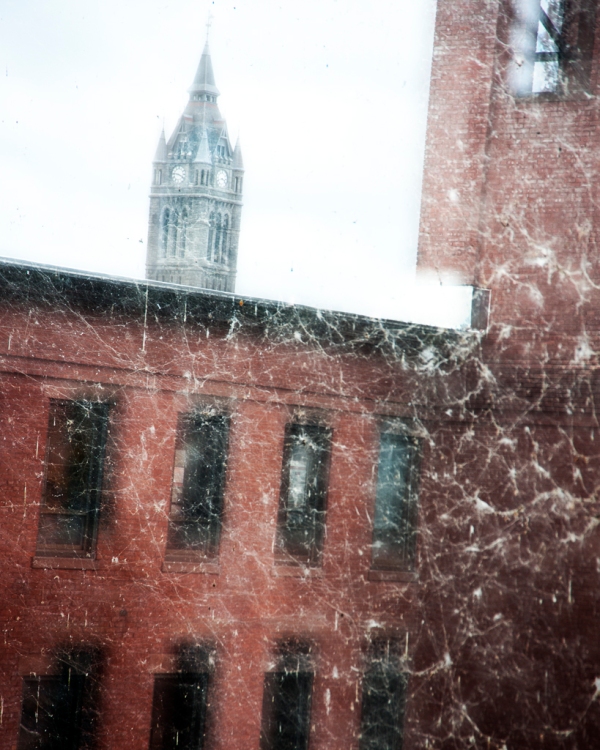
Holyoke Community College is a Holyoke on the hill. It is a great place that has similar issues to the old Pulp City. Primarily, the infrastructure is crumbling. In January 2017, we will close our black and white and color chemical darkrooms for 2 years of renovations to our large Campus Center. And that’s just one piece of a complicated network of issues.

What HCC does have are truly worthy students and top flight faculty. Above is a photo of Art Professor Frank Cressotti’s office in 2014.

This is a life-sized, printed exposure of students lying on sheets of photo paper in the HCC darkroom in 2005. Basically, this photogram and Cressotti’s office above and the prison cell below represent a Giraffe’s eye, a perpendicular, view of the world.

This cell is at the old Holyoke Jail that has miraculously avoided demolition over the past 30 plus years. My camera eye is attracted to what a majority of people would consider detritus, eyesores to be demolished. There are those of us who relish how the camera sees old paint, pocked sheet metal and other unpleasant textures. This is the opposite of flesh and fur, and equally beautiful in a photograph.

Please come to the exhibition. It is at 303 Homestead Ave. which is on a stretch of Rte 202 west of Rte 91 in Western Massachusetts. HCC is around a mile from 91. Drive into the campus, turn left at the “T” and keep driving to the top of the hill where there is the main campus entrance. There is a visitor’s parking lot just beyond the rotary. Donahue Building is a few steps down from the main rotary. It’s the building to your right. Enter Donahue and the Library is immediately on your right. Enter that lobby and you will see the Taber Gallery. Welcome.
The Last Cut and the First Roll

Gloria Rosa at Home, 1990
Gloria in her kitchen at my first portrait session for El Proyecto Holyoke. Her three daughters, Mary, Jenny and Angie, are pictured below. While editing for my HeyLook HoLyoke show at Holyoke Community College, I discovered that my vintage 40X60 inch mounted print of Gloria also exhibited a big ugly stain. That means it doesn’t make the cut.

Mary Garcia, Jenny Rosa and Children, 1990
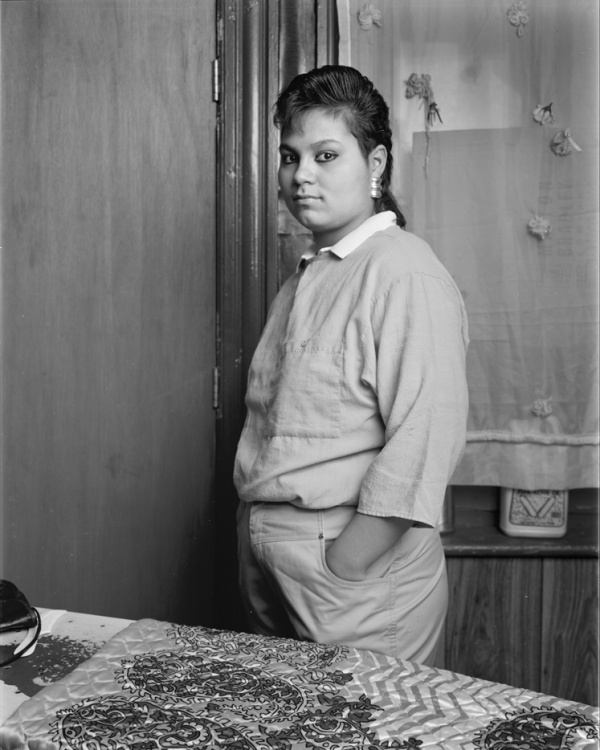
Angie, Gloria’s Middle Daughter, 1990
I do have some 8X10 contact proofs of Mary and Jenny and Angie, but they are on RC glossy paper, not exhibition quality.

Man, Baby and Boy, 1990
The above three view camera pictures were never exhibited. I do have work prints that have taken on more power over time. All our pictures become personal history after awhile. The good ones represent our literary output, visual poems so to speak.
These portraits will not make the cut, even though the big 8X10 inch negatives have become like my children. I love them now more then when they were born in the developing tray. The appearance of an image on a piece of photo sensitive film or paper in a developing tray feels almost as magical as doing almost anything with a smart phone.


Ashley Reservoir Student Fieldtrip, 1999
These film based pictures are from 17 years ago. HCC has recently paved a road from campus to the Ashley Reservoir. We will be field tripping there this fall.
I am looking forward to teaching Basic and Advanced black and white film classes. Film photography may not be as easy as tickling a smart phone. Using a film camera involves a hands-on experience in creative energy and good fortune. With a classic film camera, there is no app to make your pictures look like a “classic camera” shot. It needs your input to make “classic camera” photos as good as, or better than,your digital camera and an app. Success takes trial and error, and you can use your smart phone to make test shots. You can also use a light meter app to properly expose your film. Don’t leave your smart phones home. Photo students will be carrying two cameras this fall.

The First Roll, 1969-70
This is a picture from the first day I used a camera. I loaded my only roll of film into my new used Nikon three times to make triple exposures. There is an app for that.
La Familia Hispana

Last weekend was the 2016 Hispanic Family Festival and Western Mass Puerto Rican Parade in Holyoke. This is a great annual celebration that gave me the opportunity to photograph for my September exhibition at the Taber Art Gallery at HCC.

You can barely see the Festival stage in the background of this photograph in the beer tent. The Festival offered 6 hours of joyous Latin music every day for 3 days. Regrettably, I wasn’t recording sound. Fortunately, the weekend was a visual festival of gesture and expression.

At the Parade, I was intrigued by this street musician.

I had lunch on the first day with Mari and Rene. I asked Mari what was the best on their extensive menu. She recommended the Kielbasa. Delicious.

I disavow any relationship to lunch and this picture (above), but I was fascinated that the Porta-Pottys were so far away from the action.

As usual, I am attracted to the beauty of quality footware.

A favorite moment during the Parade was this dueling portrait session. I’d like to see what his pictures look like. Maybe I can find them on Instagram.
Below is the picture on the gallery announcement for the exhibition. All photographs ©Frank Ward
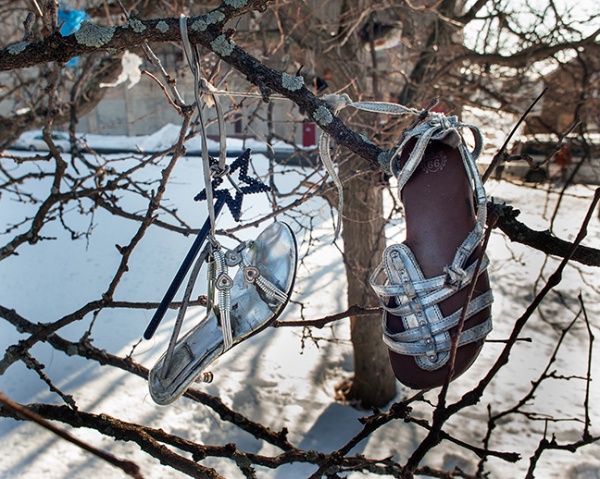
HeyLook HoLyoke: 46 years of witnessing Holyoke through a camera runs from Sept. 6th to Sept. 30th, 2016. Gallery talk and reception Wed. Sept. 14th, 11 am to 1 pm– talk begins at noon. There will be an evening reception Thurs. Sept. 15th from 5:30-7:30 pm.
The Taber Gallery at Holyoke Community College is easily accessed through the HCC Library lobby in the Donahue Building and is open to all during regular school sessions. Please call for current gallery hours: 413 552 2614.
Wake Up and Be Awesome

I made the above picture last week on High Street in Holyoke (2016). On my first trip to Holyoke in 1970, I photographed the Holyoke Police Station (below).

I haven’t gone far in 46 years. The above 2 pictures were made a block apart from each other.

Children of the Wild performed Wastelands in Holyoke last month. Walken Schweigert directed and wrote the opera based on Dante’s Inferno, and they sang it in Italian. These thespians actually fit my blog theme of Wake Up and Be Awesome.

Also in the “awesome” category, I photographed Big Fish, Angie and Matt in 2006. My wife, Vivian Leskes, asked them what they thought they would be doing in 10 years. The text is enlarged below. If anyone knows them, help me get in touch for another picture.

In Search of Holyoke
 Jenny Rosa was about 14 years old when I took this picture 26 years ago. Jenny, If you see this, send me a note. I would like to make your portrait at 40.
Jenny Rosa was about 14 years old when I took this picture 26 years ago. Jenny, If you see this, send me a note. I would like to make your portrait at 40.

I spent a lot of time hanging out on Center St. with my 8X10 Deardorff camera in the 1990s. All the buildings are gone now; they were replaced with smaller houses. Below, Wanda is hanging out with her children.

I felt welcome in “the Flats” of Holyoke. Carrying around 70 pounds of view camera equipment made me part of the entertainment in the neighborhood. I always handed out pictures created from my earlier visits. I don’t think my little digital camera makes the same impact when I photograph now.
 I tried to photograph inside as much as possible. I wish I could remember where this apartment was. I like the face in the lower right corner of the photo.
I tried to photograph inside as much as possible. I wish I could remember where this apartment was. I like the face in the lower right corner of the photo.
Below, a young man and his stereo.
 A friend pointed out how the absence of people holding smart phones and portable digital screens makes these scenes from 1990 more poignant and intimate.
A friend pointed out how the absence of people holding smart phones and portable digital screens makes these scenes from 1990 more poignant and intimate.  Even while this gentleman, a well known personality from around Center Street, is posing for his formal portrait, I feel connected to him through my large box camera. And he is addressing the camera, not distracted with a digital device.
Even while this gentleman, a well known personality from around Center Street, is posing for his formal portrait, I feel connected to him through my large box camera. And he is addressing the camera, not distracted with a digital device.
If I am remembering correctly, Vivian Leskes interviewed his grandmother Antonia.


Stuff Happens
 It may be too late for the Holyoke St. Patrick’s Day Parade. (It happened yesterday as of this writing). But it is not too late to participate in several other events.
It may be too late for the Holyoke St. Patrick’s Day Parade. (It happened yesterday as of this writing). But it is not too late to participate in several other events.

These two guys were waiting for the Holyoke Parade to begin on Sunday. I asked a nearby cop when he expected the Parade to arrive at this point along the route, he said, “in about two hours”. Here’s what to do while you are waiting for the next parade:

ZEKE Magazine is now available by subscription! Why am I telling you this? I am on the Advisory Committee of the Social Documentary Network (SDN). The organization that recently launched ZEKE. Check out www.zekemagazine.com and consider subscribing.
The next issue of ZEKE won’t be out until late April. If you want some photo action sooner than that, you can come to the Ashfield ArtSalon. It happens this Friday, March 25, 2016 at the Double Edge Theater in Ashfield on Route 116. The presentations start at 7. Admission is $5. Who are the artist’s showing their slides? I will be joined by my favorite expressionistic photographer Sarah Holbrook, premier ceramicist Mary Barringer, and New England’s number one artist, Jane Lund. Hayley Wood, the Managing Director of Double Edge , is also presenting. I suspect she is fantastic, too.
 I will be showing slides from both Central Asia and Holyoke. The above picture is from Bishkek, Kyrgyzstan. The picture below is from
I will be showing slides from both Central Asia and Holyoke. The above picture is from Bishkek, Kyrgyzstan. The picture below is from

The Puerto Rico Day Parade, Holyoke, MA.,2006.

Professor Robert Aller (Left) disguised as a professional at Deb and Chris Lizon’s wedding.
If you have read this far down the page, you are probably one of my past students or a friend. If you are also a friend or student of Bob Aller, please come to his retirement party to be held in conjunction with the Holyoke Community College Annual Student Art Show Thursday, April 14, 2016 from 7-9 pm at the Taber Gallery next to the HCC Library. There will also be festivities at the Media Arts Center in the HCC Campus Center.
All pictures Frank Ward© except for the ZEKE Magazine spread.
The art of the field trip.
 Field trip with my students, Holyoke, MA, 2010
Field trip with my students, Holyoke, MA, 2010
I am amazed at some of the crazy places where I have brought my students. This is Quantum Properties along the 3rd Level canal. Quantum had us all sign legal waivers before they would let us wander around.

Thea modeling for my class in the old factory next to the building above, 2010. This interior picture was made about a week after the above field trip. One of my students returned alone the following week to photograph more. National Geographics (TV) was there making a documentary and they recruited him on the spot to take pictures for them.
 For almost a decade I have brought students to this large “shoe tree” in Holyoke. Last winter there was so much snow from plowing the adjacent parking lot that a student and I crawled up the icy snow pile to get an elevated view of the tree.
For almost a decade I have brought students to this large “shoe tree” in Holyoke. Last winter there was so much snow from plowing the adjacent parking lot that a student and I crawled up the icy snow pile to get an elevated view of the tree.
 As I was photographing I heard a yelp. My student slipped, flew off the snow mound and landed, head first, 15 feet below me. No one was injured in the making of this picture.
As I was photographing I heard a yelp. My student slipped, flew off the snow mound and landed, head first, 15 feet below me. No one was injured in the making of this picture.
 The Wherehouse, along the 1st level canal, is another favorite Holyoke destination. This is an area with odd and interesting stuff displayed everywhere. A student became fascinated with an old fire alarm box and pulled the lever to see if it worked. It did. All we could do was wait while the fire trucks arrived.
The Wherehouse, along the 1st level canal, is another favorite Holyoke destination. This is an area with odd and interesting stuff displayed everywhere. A student became fascinated with an old fire alarm box and pulled the lever to see if it worked. It did. All we could do was wait while the fire trucks arrived.
 Fire alarm box, corner of Dwight and Main streets, 2014. This box is a couple of blocks away from the alarm my student set-off. These things look non-functional, don’t be fooled.
Fire alarm box, corner of Dwight and Main streets, 2014. This box is a couple of blocks away from the alarm my student set-off. These things look non-functional, don’t be fooled.

I photographed this dilapidated building in 2008. That is my student walking across the nail and needle scattered floor in her sneakers. Others were wearing sandals.
At times I feel the need to return to the relatively safe environment of the studio.
 I like to engage with all the studio has to offer. This picture from 2008 incorporates photograms, mannikins, a student and a projected slide.
I like to engage with all the studio has to offer. This picture from 2008 incorporates photograms, mannikins, a student and a projected slide.
 This session with a hired model in 2013 was going really well, then one of my students undressed and joined in the activities. This usually doesn’t happen. All I could do was run and get her to sign a model release.
This session with a hired model in 2013 was going really well, then one of my students undressed and joined in the activities. This usually doesn’t happen. All I could do was run and get her to sign a model release.
The train next time/To walk or to ride?
This overview from Depot Hill in Holyoke, photographed in 2016, is of the Amtrak platform built in 2015.

January 2015, the day a worker first marked construction plans in the snow. Depot Hill is in the background.

In 2014, the view from Depot Hill could benefit from a train depot in the foreground.
 Ten years ago, there was an old walkway from Bowers Street on Depot Hill (left off camera) to the intersection of Main Street and Dwight Street. If the walkway existed today, it would be next to the new Amtrak train platform. In my mind that generates the question, to walk or to ride?
Ten years ago, there was an old walkway from Bowers Street on Depot Hill (left off camera) to the intersection of Main Street and Dwight Street. If the walkway existed today, it would be next to the new Amtrak train platform. In my mind that generates the question, to walk or to ride?
 According to my picture from winter 2015, the walkway is closed. Based on what the picture sees, the walkway is more than closed, it has disappeared. Setting time aside, Pulp City is entering the realm of “magical realism”.
According to my picture from winter 2015, the walkway is closed. Based on what the picture sees, the walkway is more than closed, it has disappeared. Setting time aside, Pulp City is entering the realm of “magical realism”.
 I photographed standing in the walkway in 2006, near the “walkway closed” sign pictured above.
I photographed standing in the walkway in 2006, near the “walkway closed” sign pictured above.
 In 2014, I photographed the Historic Register worthy train station located several hundred yards north of the new Amtrak cement platform. Renovating this station would have cost the big bucks. That’s not happening soon, considering there is only one train daily. For a lot less money, Holyoke could purchase a few hundred tons of cement and make another elevated walkway. It could also be a community skateboard track. Now that’s something that enhances the question, to walk or to ride?.
In 2014, I photographed the Historic Register worthy train station located several hundred yards north of the new Amtrak cement platform. Renovating this station would have cost the big bucks. That’s not happening soon, considering there is only one train daily. For a lot less money, Holyoke could purchase a few hundred tons of cement and make another elevated walkway. It could also be a community skateboard track. Now that’s something that enhances the question, to walk or to ride?.

While I was working on this post I came across this wonderful picture by Dorothea Lange from 1937. Over 80 years ago, to walk or to ride was the question. Now, the answer is still based on the same reality. If you want the answer, simply check the price of an Amtrak ticket.
HeyLook, HoLyoke

Zoning Map of Holyoke, Massachusetts
HeyLook, HoLyoke is the working title for my most recent pictures from the “Pulp City”. HeyLook is an anagram for Holyoke. The map on my workroom wall is inspiring me to consider all the possibilities of Holyoke.
I began photographing “the jewel of the Connecticut River Valley” in the early 1970’s while I was a student at UMass. I also made a series of Black and White 8X10 inch view camera portraits there in the late 80’s and early 90s.

Fernando Gonzales, The Salvation Army, 1989
My wife, Vivian Leskes, conducted and transcribed interviews in Spanish and English with the people I photographed. Here are a couple of my favorites.

I was concerned about Paco (Luis). He was the guy who helped me to not get ripped off or not have my car stolen. He was a youth at risk. I ran into him several years after this picture was created and he had turned his life around. I wouldn’t be surprised if he ended up going to Holyoke Community College.

Jenny was only 13 or 14 when this picture was made. I love the interview she gave Vivian. She said, “I’d like to live in Detroit. I’ve heard about it and it seems nice. They have a curfew and if they catch you outside, they bring you home. That would be good for my kids.” She didn’t want another boyfriend until she turned 17. “I don’t want to marry anybody from Holyoke. I want to marry somebody who’s built, has a good job, and he better buy me the furniture before we get married.” I asked about her several years later. The block of Center St. where Paco and Jenny lived was demolished, she had moved out, had a child, and was living in Springfield.

I photographed this guy in the Center St. neighborhood. We couldn’t find him again to do an interview.
I did rephotograph a few of the people from this original Holyoke Project in 2005. I had donated the original 40X60 inch mounted prints with text to the Holyoke Library. They didn’t have room for them anymore and gave some pictures to a woman I had photographed. She also acquired my huge photograph of her husband. She was now divorced and took great pleasure in destroying the life-sized portrait of her ex with a wrecking hammer.
2 Magazines, 2 Eggspressos

Glenn Ruga, founder of ZEKE Magazine, speaks with photojournalist Scott Brauer at the Magazine launch party outside Boston.
Thursday April 23rd was the launch for ZEKE: The Magazine of Global Awareness, the new semi-annual digital and print publication from Social Documentary Network. Subscriptions are available HERE.

Social Documentary Network founder and publisher of ZEKE Magazine, Glenn Ruga, speaks at the Digital Silver Imaging Gallery in Belmont, Massachusetts.
Here I am holding the first issue of ZEKE. It is available in print and digital form.
I’m holding an Olympus Pen E-P2. I just found it at the dump last week. It needed a new battery. I love the dump.
I’m on the advisory board of Social Documentary Network, but I am not in the magazine. I am in the second issue of Holyoke Transfer Magazine.

Holyoke Transfer 2 is a 169 page magazine of art. I have three 2 page spreads covering recent and older pictures from Holyoke.
Torsten Zenas Burns is the creative juggernaut behind Holyoke Transfer 2.
I love Holyoke. If it was in Italy, it could be Venice. It is one of just a few US canal cities. With some scrubbing and several million dollars, it could be the paradise of the Connecticut River Valley.

Holyoke’s canals get drained once or twice a year. I try to schedule a class field trip to coincide with the process.
You can get a copy of Holyoke Transfer Magazine HERE.
Yes, my home rebuilt espresso machine is doing dual duty as an egg maker.

Thanks to The Daily Coffee News, I’ve discovered two great methods for cooking eggs with a steam wand.
First, is the 3 minute poached egg. I set up a mug with a small stainless bowl for the egg. Add a little oil so the egg doesn’t stick in the bowl.

When everything is aligned, I cover the mug and steam wand tip with tinfoil plus several towels over the tinfoil to keep the steam in.
Three minutes is a lot of steam and a consumer espresso machine may not be able to produce that much heat. Make sure you blow out the extra water from the wand before you start steaming or scrambling your eggs.
Flip the little fellow over into a small plate and add salt, pepper and olive oil (or butter). Enjoy.
Scrambled eggs are easy. All you need is a porcelain pitcher to mix 2 or 3 eggs with a spoonful of oil and some salt.

Whip the ingredients with a fork , purge the water out of your steam wand, insert it into the eggs and turn it on. 30 seconds (or less) later you have the lightest, fluffiest scrambled eggs you can imagine.
I like quality olive oil drizzled on my toast and on my eggs. You may prefer butter.
Pictures from Home/ The Harvest and the Coffee
I’ve been spending time in Ashfield getting ready for the coming semester. Vivian is hard at work with the garden. We lined our blighted tomatoes along the porch screens to save what we could (which was about 10%). Garlic is on the floor on the sleds.
One favorite aspect of the harvest is the fermentation. So far this year’s highlight is our first batch of kimchee made from garden fresh Chinese cabbage. Better than the local stuff from the Korean market.
I just realized that I don’t have a picture of our pickles. My first choice are the half sour brine pickles that ferment for about a week. We’ve got a batch in the fridge now with a couple of more crocks still fermenting. Vivian also makes jars of dill pickles. Below is one of her pictures.
She sure makes a good picture of pickles. I should get her an iPhone tripod for the indoor shots. Although it is just fuzzy on one side. Fixing it looks like a job for Instagram.
If Vivian’s passion is the garden, mine is the coffee, specifically espresso.
Actually, my be-at-home passion is wrapped up in the totality of espresso– from bean to cup. Above is a 20 year old machine that I got from Melissa, the professional coffee roaster and barista at The Elbow Room in beautiful downtown Williamsburg. I got it out of her cellar in March and I dismantled it in April.
I was a complete novice to espresso machine restoration. I always like to take things apart, though.
The Premier sat around in pieces for a month while I descaled it and decided which parts needed replacing.
When May came I began to think that I wasn’t going to get it back together again. There was one ace-in-the-hole. I had meticulously photographed every step of the take-down with my iPhone. I just had to follow the pictures in reverse.

The copper and chrome skeleton begins to reassemble itself with the help of many wrenches and lots of teflon tape.
Next, the testing came. My mass of pipes and gaskets was not making coffee, or pumping water. The machine sat there for another month.
It became an 80 pound conversation piece. Meanwhile, I had my coffee scene together– Hottop coffee roaster on the left, Pharos hand grinder to its right, next the Mazzer Mini electric grinder and then the LaPavoni Professional lever machine. I was making great espresso, but there was an elephant…
No matter how I looked at the Premier, it didn’t make me feel like a successful barista. It needed a rebuilt water pump and who knew what else.
I extracted my first espresso from the Premier on July 4th. The rebuild took me almost 4 months. I still only have one brew group working, but I needed to pause and enjoy some great coffee. You can see the rubber band on the left brew group. I use that to hold a thermometer to take its temperature. Coffee likes to be brewed a bit below boiling.
So now you know what I do when I am not teaching or running around the world making pictures.

I thought my construction picture from Siberia would be a good lead for my friend and colleague Glenn Ruga, who is reworking socialdocumentary.net with fresh ideas and a fresh design. Saturday, August 9, 2014 is the last day of the SDN Kickstarter campaign. There is still time to jump on board. A pledge of $100 or more will even get you a print by Frank Ward (me). Check out SDN on Kickstarter and help us out. I say “us” because I have the pleasure of being on the SDN board. Your pledge doesn’t support anyone on the board. It will help support documentary photography and photographers worldwide.
Every day that I teach photography I realize that documentary work, and all creative photography, needs our support. I look into the faces of my students knowing that traditional careers in photography are few. A successful life in photography is now more likely to be marked by a strong web presence than a portfolio of tearsheets from magazines and newspapers.
The old saying that a photographer is best served by a good pair of shoes still holds true. I will also add that some alchemical combination of ego and personality will serve you better than the best combination of camera and lens. An easily bruised ego and an introverted personality won’t get you far in the photo world. But, a delicate ego or an introverted nature is no problem on their own. Richard Avedon used to sit in disguise where he was having an exhibit primarily to satisfy his ego. Introverts make great photographers, but you have to make the outside contact to get the assignment or sell the picture.
So it comes down to a willingness to bare your soul. I’ve had projects that have left me in tears (Bosnian refugee camps), or swearing that I’d never go back (New England Barrooms). And that brings me to the primary requirement for a life in photography. You have to do it because it is what you are driven to do. You keep on going back no matter how miserable it makes you feel or how broke you are. A job on the side may help if you are too broke, but a photographer is never too broke-down to make the picture.
Pictures from the Former Soviet Union

During the month of February, I will be exhibiting pictures from The Drunken Bicycle- Travels in the Former Soviet Union at the Meekins Library in Williamsburg, MA. On February 19th at 7:00, I will do a presentation with Vivian Leskes, author of Lost in Siberia.
SocialDocumentary.net –CALL FOR ENTRIES
“Using the power of photography to promote global awareness” is the tagline for a photo contest that goes beyond the standard parameters of most picture competitions. SDN‘s annual Call for Entries is an open invitation to advance your career as a documentary photographer. Two Grand Prize winners will be awarded $4000 each and each will spend up to two weeks documenting the global health projects of Management Sciences for Health. Yes, instead of relying on the usual network of photography agencies to hire talented picture professionals, MSH wants to give the opportunity to members of the SocialDocumentary.net community. A $35 fee will allow you to join SDN, upload a portfolio, and be entered for the Call for Entries. Your portfolio will be available for viewing to anyone who visits socialdocumentary.net.
There is a $1000 cash Documentary Award for a third winner and a New York City exhibition that will include 2-3 honorable mentions as well as the 3 winners. The deadline is September 28, 2013. Check out more information and details here and here.
In addition to this annual Call for Entries, SDN offers a monthly award of $200 for the best portfolio uploaded that month. I had the opportunity to vote on this month’s winning entry. In support of full disclosure, I am on the Advisory Board for SocialDocumentary.Net. I am not on the selection committee for the current Call for Entries.
Photos by Frank Ward.
The above pictures are from two not-so-recent projects. The top image of an elephant bathing in the water supply of a village in South India was created when I was part of a Rotary Foundation Group Study Exchange photographing health issues in India (1999). The lower picture of a young boy was made from a military vehicle while embedded with the U.S. forces stationed in Kosovo. I was there under the auspices of the Center for Balkan Development bringing aid to help rebuild Kosovo (2000).
New Found Lands
Gros Morne, Newfoundland, Canada. All photographs 2013 by Frank Ward.
It is time to fire up The Coruscating Camera blog and begin a semester of photo work. This post is illustrated with pictures from a recent journey to Cape Breton Island and Newfoundland.
Bedsprings, Viking Trail, Northern Peninsula, Newfoundland.
According to my MacBook dictionary, the word ‘coruscating’ means “sparkling, flashing and brilliant in content or style.” When I am photographing and feeling ‘in the zone’, I recognize the world as coruscating with energy.
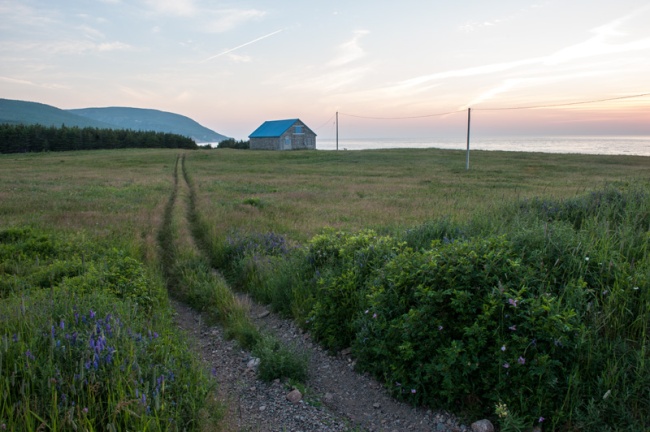 Pleasant Bay, Cape Breton, Nova Scotia.
Pleasant Bay, Cape Breton, Nova Scotia.
The most immediate energy available to the photographer is light. Recognizing the most favorable light invites us into the realm of coruscation. This picture and the next were taken in sequence one evening along the Cabot Trail.
Volunteer Fire Department, Cape Breton.
The first view is just to the left of where I made the second photograph. Actually, there was a very nice picture (below) in between the two pictures above.
Pleasant Bay, Cape Breton.
The master color photographer Jay Maisel told me to take lots of pictures of the same stuff, and to bracket my camera settings. I never really know what I will be attracted to after the initial exposures.
Jay also says to photograph before 10 AM and after 4 PM. The light is best in the early morning and early evening. I still photograph anytime day or night, but he is right. The light is best when it is low and sweeping across the world.
Codroy Valley, Newfoundland.
Sunset is a great time to photograph, except that I’m not too interested in sunset pictures. I was attracted to the light reflecting off the white painted surface of this outbuilding along the Cabot Strait.
Western Brook Pond, Newfoundland.
Here is the morning mist on a former fjord in Gros Morne National Park.
I like inclement weather. The pictures above and below were made just after a rain.
Let’s integrate the conditions of the outer world into our inner world of perceptions and preferences.
Recognize the potential in the world around you, and Allow it to become your perception.
 Boat dock, Western Brook Pond.
Boat dock, Western Brook Pond.
I am referring to the acronym RAIN, suggested by Tara Brach, a teacher of present moment awareness. Her first step is to Recognize what is going on in any moment. You don’t need a camera to do this. The next step is to Allow what arises to simply happen without judgement.
Port Saunders, Northern Peninsula, Newfoundland.
Tara then asks us to Investigate, this is where a camera can come in handy. With or without a camera, investigation can lead to insight.
Port aux-Basques, Newfoundland
The last letter in our acronym is for Non-attachment. This is the most important factor for both the person and the photographer. Attachment to our current situation leads to any number of contentious issues. You can get frustrated because you are not getting the results (pictures) you want. Or you can project into the future about the huge rewards you will receive for the brilliant work you are making. My ‘N‘ in RAIN is also for Now. Too many thoughts can get in the way of experiencing what is in front of me and my camera. If thinking takes me away from Recognizing, Allowing and Investigating what is in front of me, I bring awareness back to the Now. A clear mind makes clear pictures.
Frank Ward in Exposure 2013 at the PRC in Boston
The 18th Annual Photographic Resource Center Juried Exhibition opens June 6, 6:30-8:00. That is tonight at 832 Comminwealth Avenue, Boston, MA. This Accordion Player is on the high pastures of Central Asia off a road heading from Osh, Kyrgyzstan to Kashgar, China. There will be a half dozen of my pictures from The Drunken Bicycle series at the PRC with seven other selected photographers.
Neither of the above pictures are in the exhibit. You will have to go to see what is included.
Claire’s Footprint
My daughter Tobey was telling me about tiny houses. These alternative homes are often no bigger than 500 square feet and are an attractive option for those with the intention to live with a smaller footprint. That’s Tobey and Porgy in the picture above as we walk to Claire’s house, about a mile down a mud road.
Here are Claire’s feet as we stand in her kitchen. She painted the floor with leftover house paint.
Tobey admires the kitchen. The house is off the grid. Claire has solar power backed up by a generator. Her stove is a combination of wood and gas and her refrigerator is propane powered.
Claire’s water system is solar powered. She says she has to drain the pipes if she is away overnight in the winter.
This is Cinderella, she got her at FAO Schwartz in New York when she was a child.
The house is beautiful and well swept.
It could be a museum.
The pictures on the walls are amazing, and she does her own wallpapering.
I don’t mean to give you the idea that Claire lives as if in an earlier century. She has a laptop and today’s New York Times.
Claire doesn’t even have a tiny house. She simply has a small footprint. Her choice of life style reminds me about intention. We all live with intention. We simply don’t ask ourselves what our intentions are. When you think about your intentions, dive past the layers and daily reasons for doing what you do. Look into your root aspirations and you may find that your deepest intentions should not be overlooked.

















